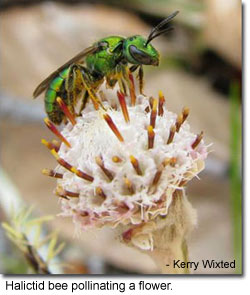 Did you know that over 95% of the insects aren’t pests? Some insects help pollinate fruits and vegetables while others take care of common garden pests. By limiting pesticide use in your yard and by providing the right type of plants, you can encourage beneficial bugs to inhabit your backyard habitat which will reduce your need for pesticides.
Did you know that over 95% of the insects aren’t pests? Some insects help pollinate fruits and vegetables while others take care of common garden pests. By limiting pesticide use in your yard and by providing the right type of plants, you can encourage beneficial bugs to inhabit your backyard habitat which will reduce your need for pesticides.
Steps for Encouraging Beneficial Insects
- Design your garden or backyard to have blooming plants throughout the spring, summer and fall to provide nectar and pollen.
- Provide a water source.
- Provide shelter such as leaf litter on the ground or groundcovers.
- Have patience and tolerate a few pests until beneficial insects establish.
- Identify pest problems before treating and choose treatments according to the pest.
- Resist the urge to spray when you first see damage, and if spraying is necessary, consider using safer pesticides.
Least Toxic Pest Products
Problem | Active Ingredient |
| Aphids | Ladybugs |
| Caterpillars |
Bacillus thuringiensis var. kurstaki |
| Fungal Problems | Copper octonate
Extract of Neem oil
Potassium bicarbonate (85%)
Sulfur |
| General Insect Pests | Capsaicin and related capsaicinoids
Extract of Neem oil
Fatty Acid Soap
Potassium salts of fatty acids |
Lawn Pests
(Grubs and Fleas) | Cedar oil (2%)
Steinernema carpocapsae (Nematodes) |
| Mosquito Larvae |
Bacillus thuringiensis var. iseaeliensis (10%) |
| Snails and Slugs | Iron phosphate (1%) |
|
Note: While products like pyrethrum and rotenone are naturally-derived, they are broad spectrum insecticides which can kill both pests and beneficial insects. Therefore, it is best to use narrow spectrum insecticides when possible. |
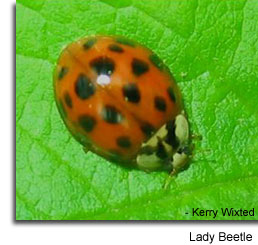
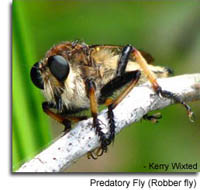
Common Beneficial Insects
Insect | Food | Attractants | |
Assassin Bug
| Beetles, caterpillars, other bugs | Sunflowers |
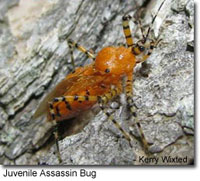
|
Damsel Bugs
| Caterpillar eggs, fleahoppers, leafhoppers and spider mites | Clover |
| Damselflies & Dragonflies | Mosquitoes, gnats and flying insects | Open water, small ponds, open fields
|
Ground Beetles
| Snails, slugs and root-feeding insects | Stone pathways, clover & compost piles |
| Honey Bees | Pollen and flower nectar | Flowers such as asters & goldenrods
|
| Lacewings | Aphids, small caterpillars, whiteflies and thrips | Nectar plants including geraniums |
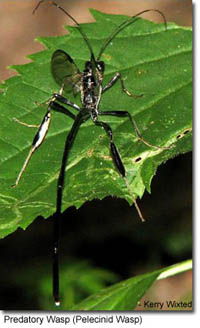
|
| Lady Bugs | Aphids, scales, mites and soft-bodied pests | Nectar plants including geraniums |
| Praying Mantis | Other insects | Flower & vegetable gardens |
| Predatory Flies | Caterpillars, beetle larvae and sawflies | Nectar plants |
| Predatory Wasps | Other insects | Pollen producing plants like fennel |
| Spiders | Other insects | Flower & vegetable gardens |
| Syrphid Flies | Aphids, beetles, caterpillars and thrips | Composites like dill, fennel and coreopsis |
| Wheel Bugs | Caterpillars, moths, squash bugs, cucumber beetles | Shrubs and trees |
|
Note: While many stores sell beneficial insects, it is best to attempt to attract your own. Sometimes, these insects are not sustainably collected from the wild, or those that are mass reared may have diseases that could be accidentally introduced into wild populations. |
Many wasps and other natural enemies of insects rely on plant nectar or pollen as adults and invertebrates as juveniles. Therefore, planting flowers that attract adult predators and parasitoids can increase natural pest control in your backyard. Predators are animals that attack and consume other animals whereas parasitoids live in or on their host and kill the host in the process. Most parasitoids are specialists and only attack certain species. For example, a common parasitoid is the braconid wasp (Cotesia congregatus) which lays its eggs inside of tobacco and tomato hornworms.
| Common Name | Scientific Name | Bloom Time | Notes |
|---|
|
Golden Alexanders |
Zizia aurea | April-June | Host plant for black swallowtail |
|
Canada Anemone |
Anemone canadensis | May-July | Likes moist soil |
|
Dill |
Anethum graveolens | May-June | Attracts green lacewings, syrphid flies, and ladybugs; host plant for black swallowtail |
|
Lanceleaf Tickseed |
Coreopsis lanceolata | June-October | Great bee and butterfly nectar plant |
|
Indian Hemp |
Apocynum cannabinum | June-August | Nectar source for monarchs |
|
Meadowsweet |
Spiraea alba | June-September | Grows best in western Maryland |
|
Spotted Beebalm |
Monarda punctata | June-October | Attracts wasps |
|
Wild Bergamot |
Monarda fistulosa | June-September | Attracts wasps |
|
Canada goldenrod |
Solidago canadensis | July-October | Great nectar source for migrating monarchs; attracts beetles and wasps |
|
Boneset |
Eupatorium perfoliatum | July-October | Great for bees and butterflies |
|
Blue Lobelia |
Lobelia siphilitica | August-October | Likes moist soil |
|
New England Aster | Symphyotrichum novae-angliae | August-October | Great nectar source for migrating monarchs |
When planting, it is best to either interplant the species listed above within your garden design or to create small borders around your garden. These flowers can be used in all types of gardens from edible gardens to pollinator gardens.
Resources:
Fiedler, A., Tuell, J., Isaacs, R., and D. Landis. 2007.
Attracting beneficial insects with native flowering plants. Extension Bulletin E-2973.
Xerces Society. 2014. Farming with Native Beneficial Insects: Ecological Pest Control Solutions. ISBN-13: 978-1612122830
For Additional Information, Contact:
Maryland Department of Natural Resources
Wildlife and Heritage Service
Tawes State Office Building, E-1
Annapolis MD 21401
410-260-8540
Toll-free in Maryland: 1-877-620-8DNR
[email protected]
Acknowledgements:
All photos by Kerry Wixted